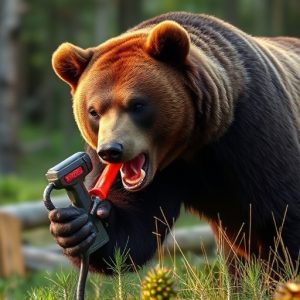Maximize Bear Spray Stopping Power: Optimize Distance & Effective Use
The optimal distance for deploying bear spray (20-30 feet or 6-9 meters) is crucial for its effectiv…….
The optimal distance for deploying bear spray (20-30 feet or 6-9 meters) is crucial for its effectiveness as a defense mechanism, ensuring the bear is coated with chemicals without putting oneself at risk. This range allows for the bear to react and retreat, enabling safe human interaction while minimizing disruption to the animal's natural behavior. Factors like distance, environmental conditions, spray quality, pressure, and technique impact effectiveness; proper training and practice at controlled distances enhance muscle memory and quick decision-making skills during unpredictable encounters.
Bear spray is a powerful tool for self-defense against aggressive bears. In this article, we explore its maximum stopping power and provide insights on optimal distance for application. We’ll delve into the composition and effectiveness of bear spray, as well as factors influencing its range and performance. Additionally, we emphasize the importance of training and practice to ensure effective use in emergency situations, all with a focus on maximizing your safety when facing these formidable creatures.
- Understanding Bear Spray: Its Composition and Effectiveness
- Optimal Distance for Application: Maximizing Stopping Power
- Factors Influencing Bear Spray Range and Performance
- Training and Practice: Ensuring Effective Use in Emergency Situations
Understanding Bear Spray: Its Composition and Effectiveness
Bear spray, also known as bear repellent, is a powerful defense mechanism designed to protect individuals from aggressive bears in their natural habitats. Its composition typically includes capsaicin, a compound derived from chili peppers, along with other chemicals and preservatives. This potent mix creates a highly effective barrier against bears by causing temporary but severe irritation to their eyes, nose, and respiratory system.
The optimal distance for deploying bear spray is a crucial factor in its effectiveness. Experts recommend spraying from a safe distance, usually around 20-30 feet (6-9 meters), allowing the chemicals to reach the bear without putting yourself too close. This range provides ample time for the bear to react and retreat, ensuring your safety while minimizing the impact on the animal’s behavior and habitat.
Optimal Distance for Application: Maximizing Stopping Power
The optimal distance for applying bear spray is a crucial factor in maximizing its stopping power. It’s recommended to keep a safe distance of 20-30 feet (6-9 meters) from an approaching bear. At this range, the spray can effectively reach and coat the bear’s face, eyes, and nose, which are critical areas for irritation and disorientation. Exceeding this distance may result in the spray spreading too thinly or missing the bear entirely, reducing its effectiveness.
Understanding the optimal distance allows users to time their spray application correctly. When a bear is within this range, spraying directly towards its face will create a barrier of capsaicin, the active ingredient in bear spray, which can temporarily disable the bear’s ability to see, breathe, and move, giving you valuable time to retreat or defend yourself. Practicing spray techniques at controlled distances ensures that when faced with an actual bear encounter, you can make the most of your bear spray’s stopping power.
Factors Influencing Bear Spray Range and Performance
The effectiveness of bear spray as a defense mechanism is heavily influenced by various factors, including the user’s distance from the bear and environmental conditions. The optimal distance for bear spray application is a crucial consideration. At close range, say within 20 feet (6 meters), bear spray has been proven to be highly effective in immobilizing bears due to the high concentration of pepper spray particles in the animal’s eyes and respiratory system. However, beyond this point, the range and performance start to diminish.
Several variables contribute to the reduced stopping power at longer distances. Wind direction and speed play a significant role, as they can carry the spray away from the target or cause it to spread more widely, decreasing its concentration. Additionally, the type of bear spray, its pressure, and the user’s technique all impact the range. Using high-quality bear spray with proper pressure ensures better distribution of the irritants. Experts recommend practicing spray techniques in controlled environments to ensure users can deploy the spray accurately at optimal distances for maximum effectiveness against bears.
Training and Practice: Ensuring Effective Use in Emergency Situations
Training and practice are crucial components in ensuring effective use of bear spray during emergency situations. It’s important to familiarize yourself with the optimal distance for bear spray application – generally recommended as 25-30 feet (7.6-9 meters) – so that you can deploy it accurately under stress. Regular simulations, both in controlled environments and field training exercises, help build muscle memory and quick decision-making skills. This preparation is vital, considering the unpredictable nature of bear encounters, where every second counts.
Through practice, individuals learn not only the physical action of spraying but also crucial situational awareness – recognizing signs of aggressive behavior, understanding wind direction, and knowing when to retreat or stand your ground. These skills, combined with knowledge of bear behavior, significantly enhance safety during potential encounters.
Bear spray is an essential tool for navigating wild environments, but its maximum stopping power depends on understanding its composition, application distance, and training. By maintaining an optimal distance of around 20-30 feet (6-9 meters), users can ensure the best chance of deterring an aggressive bear. Various factors, such as weather conditions and terrain, influence the spray’s range and effectiveness, emphasizing the need for awareness and practice. Regular training sessions enable individuals to respond calmly and effectively in emergency situations, making bear spray a reliable defense when used correctly.


